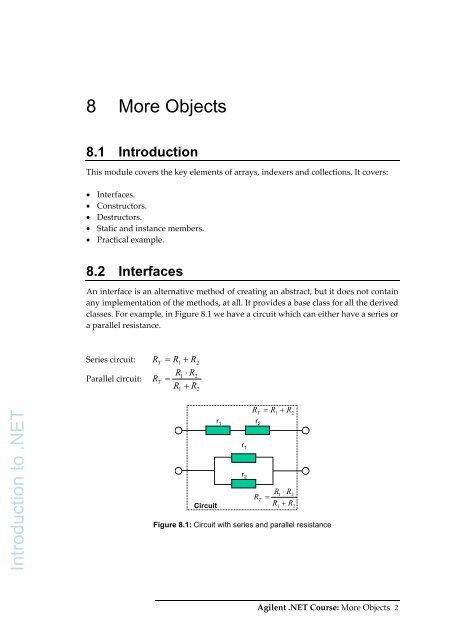Complete set: Intro to C - Bill Buchanan
Complete set: Intro to C - Bill Buchanan
Complete set: Intro to C - Bill Buchanan
Create successful ePaper yourself
Turn your PDF publications into a flip-book with our unique Google optimized e-Paper software.
8 More Objects<br />
8.1 <strong>Intro</strong>duction<br />
This module covers the key elements of arrays, indexers and collections. It covers:<br />
• Interfaces.<br />
• Construc<strong>to</strong>rs.<br />
• Destruc<strong>to</strong>rs.<br />
• Static and instance members.<br />
• Practical example.<br />
8.2 Interfaces<br />
An interface is an alternative method of creating an abstract, but it does not contain<br />
any implementation of the methods, at all. It provides a base class for all the derived<br />
classes. For example, in Figure 8.1 we have a circuit which can either have a series or<br />
a parallel resistance.<br />
Series circuit: R T<br />
= R 1<br />
+ R2<br />
Parallel circuit:<br />
R1<br />
⋅ R2<br />
R T<br />
=<br />
R + R<br />
1<br />
2<br />
duction <strong>to</strong> .NET<br />
<strong>Intro</strong><br />
Circuit<br />
R T<br />
= R 1<br />
+ R2<br />
r 1 r 2<br />
r 1<br />
r 2<br />
R ⋅ R2<br />
R<br />
1<br />
R T<br />
=<br />
R1<br />
+<br />
Figure 8.1: Circuit with series and parallel resistance<br />
2<br />
Agilent .NET Course: More Objects 2










![Unit 5. Switches and VLANs [PDF]](https://img.yumpu.com/34422504/1/184x260/unit-5-switches-and-vlans-pdf.jpg?quality=85)





